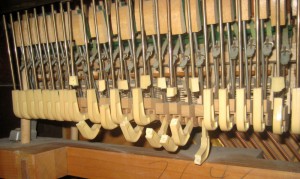
In an effort to make less expensive pianos that would fit into smaller spaces, piano companies started making the “spinet” piano in the 1930’s. The spinet is the shortest of pianos, usually around 37-40 inches high, and considerably thinner than other sizes of uprights. The defining element of the spinet is the “drop action.” The action (hammers and escape mechanism) usually sits right on top of the keys, so when you push down a key, it pushes the action parts up and propels the hammer forward. In the spinet, the action sits below the keys which a connecting rod (or “sticker” in piano technicians’ language) that reaches down from the key and pulls the action parts up instead of pushing. This makes it possible to make a piano cheaper and smaller, but it also decreases the performance and reliability of the action.

During the 60’s and 70’s, piano makers decided it was a good idea to use plastic parts in these spinet actions without properly testing them. Fifty years later, I’m seeing these plastic parts, usually the “elbow” that connects the sticker to the rest of the playing mechanism (see above diagram), getting brittle and breaking, which leaves the key disconnected from the hammer and totally useless.
The repair, while a little time consuming, isn’t that hard and can give new life to an otherwise well-functioning piano. I recently replaced 7 broken plastic elbows on this small spinet.
If you are looking at buying a spinet piano, I recommend taking off the lower panel and checking the action for plastic elbows. They will eventually become a problem and need to be replaced. Either stay away or plan on having me replace those parts someday! If you have a small piano with some keys that stay down and no longer play, its possible your piano has broken plastic parts that need to be replaced. Call me up and I can repair them for you!




